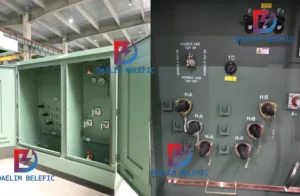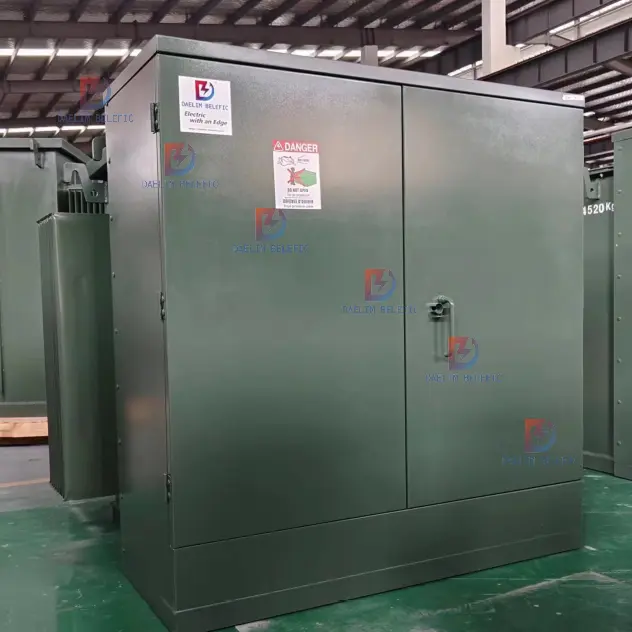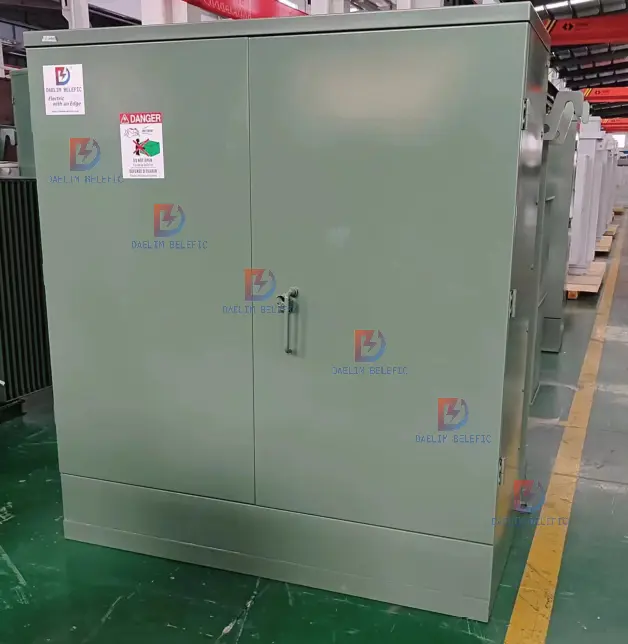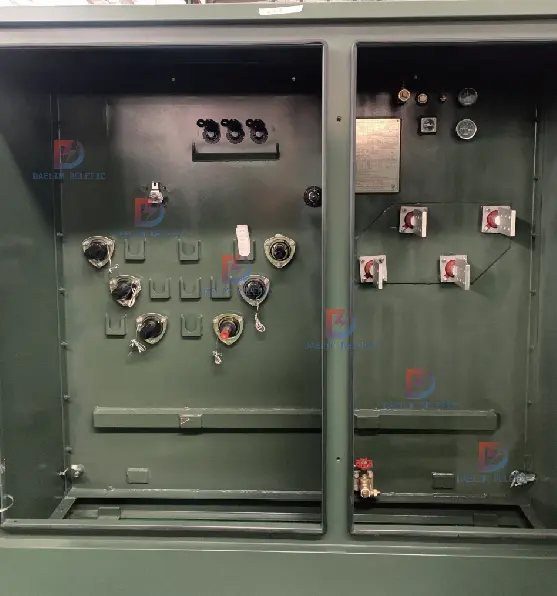
ELECTRIC, WITH AN EDGE

A 2500 kva pad-mounted transformer is a kind of energy distribution transformer developed for ground-level installation. It is encased in a secured steel closet and placed on a concrete pad, that makes it distinct from other sorts of transformers that are either pole-mounted or positioned within a substation. These transformers are generally used in suburban, metropolitan, and industrial parks to step down high-voltage electricity from the energy grid to a reduced voltage appropriate for residential or business usage.
Pofessional Manufacturer of Pad Mounted Transformer Substation Transformer,HV Power Transformer Single Phase Transformer IEEE/ANSI,CSA,DOE,AS/NZS,IEC and etc。standards
Security and Security: The solid unit of a pad-mounted transformer enhances safety and security, especially in inhabited areas. It stops unauthorized accessibility and lowers the threat of mishaps or vandalism. Visual Appeal: These transformers have a lower account and are more very discreet than their pole-mounted counterparts, allowing them to blend in with their environments. They can be tailored with paint or style elements to boost their aesthetic appeal, making them an extra eye-catching alternative for city atmospheres. Room Efficiency: Pad-mounted transformers need less upright area than pole-mounted ones. They are optimal for areas where area goes to a premium. Minimized Noise: The enclosures are designed to reduce noise, which is useful in domestic and business areas. Maintenance Convenience: Having gain access to at ground level streamlines the process for technicians to carry out assessments, upkeep, and repair services.
Learn more about the : How Much Dose the 1000 kva Pad mounted Transformer Cost?
High Voltage Reception: The transformer gets high-voltage power from utility power lines. Voltage Transformation: Inside the transformer, the high voltage is stepped down to a lower voltage. This process takes place via electro-magnetic induction between coils (windings) inside the transformer. The key winding receives the high voltage, and the second winding results the reduced voltage. Electrical power Distribution: After being transformed to lower voltage, the energy is then dispersed to homes, commercial facilities, or commercial websites through below ground high-voltage line. The transformer is outfitted with a heat-dissipating and protecting fluid, such as mineral oil or FR3 liquid, which assists to cool the device throughout procedure and shield its inner parts from thermal damage. Pad-mounted transformers, with their ground-level access, protected units, and efficient style, play a crucial role in the distribution of electric power in numerous setups.

Below’s an in-depth electrical wiring layout of a 2500 kVA pad-mounted transformer:
Main and Secondary Windings: These are the coils of wire through which power flows. The key winding gets high-voltage power from the power grid, while the additional winding supplies lower-voltage electrical power for distribution.
Voltage Regulators: These units make certain that the transformer’s result voltage remains stable, even when the input voltage fluctuates. They modify the voltage degree to prevent any inconsistencies in the result.
Safety-Critical Links: Grounding links play an essential duty in making sure security by redirecting surplus power to the ground, consequently protecting against unsafe electrical overloads.
Air Conditioning Systems: Transformers produce warmth, and cooling down systems (like fans or radiators) aid dissipate this heat to stop damages.
Bushings are tools that provide insulation for electrical conductors as they pass through the based barriers of a transformer, making certain safe flow.
Safety Devices:
Accuracy in Installation and Repair: The appropriate layout makes sure that technicians install or fix the transformer correctly, which is important for safety and security and capability.
Reliable analytical: Utilizing a comprehensive wiring representation helps determine and resolve troubles, reducing disruptions.
Conformity with Standards: Using the right diagram makes certain adherence to safety and efficiency requirements.
Customization for Specific Applications: Transformers vary in their design depending upon the application. The proper electrical wiring diagram takes into account these details requirements.
For the real implementation, it’s important to adhere to the particular maker’s standards and safety criteria. The provided layout is a basic representation and might vary from particular manufacturer designs.
Learn more about the : Choosing The Right Transformer: 1500 KVA Pad Mounted Transformer Explained
The cost of a 2500 kVA pad-mounted transformer can differ dramatically depending on numerous aspects such as the manufacturer, specs, and extra functions. Based on current listings, the prices for these transformers range from roughly $109,221.23 to $193,543.38. For example, a 1.12 MVA pad-mounted transformer from Larson Electronics is valued at $109,221.23, and one more model from the same firm with a power score of 2.5 MVA is valued at $193,543.38.
Modification: Custom specifications or modifications to fit details applications can add to the expense.
Take into consideration the special requirements of your application and the total expense of ownership when making your buying decision.
Learn more about the : 750 kVa Pad Mounted Transformer, The Ultimate Guide
Right here is a listing of suppliers that market 2500 kVA pad-mounted transformers, including their contact details and web links to their sites:
Description: Offers a series of pad-mounted transformers, consisting of refurbished devices.
Contact Information: Not directly provided on the web site. Interested purchasers can contact them by means of their internet site for even more details.
This transformer from Larson Electronics provides a 2500kVA capability, featuring a 4160V Delta Primary and a 480GRDY/277 Grnd Wye Secondary. It’s designed with oil-cooling for reliable warmth administration. You can discover more info and call details on their internet site.
Atlas Electric provides Cooper 2500 KVA Pad-Mount Transformers in different arrangements, such as 13800-480Y/ 277 volt, three-phase. To find out more, visit their website for certain contact information.
Summary: Provides a series of pad-mounted transformers from 750 kVA to 2500 kVA in three-phase configurations.
Internet site: Daelim – Daelim – 750 kVA to 2500 kVA 3 Phase Pad-mounted Transformer
Get in touch with Information: For even more details, see their website and use the call information supplied there.
VanTran Industries gives pad-mounted transformers in both single and three-phase designs, with abilities rising to 10,000 kVA and the flexibility of voltage selections as much as 46,000 V. For added info, please visit their website or call them straight.
The best approach for potential clients thinking about getting a 2500 kVA pad-mounted transformer is to check out the vendors’ internet sites and contact them directly making use of the provided call details to get personalized details and estimate.

Here is a table of specifications for a 2500 kVA pad-mounted transformer:
| Specification | Details |
|---|---|
| kVA Rating | 2500 kVA |
| Primary Voltage Rating | Varies (e.g., 12470Y/7200V, 13200V, 13800V) |
| Secondary Voltage Rating | Varies (e.g., 480Y/277V, 480GRDY/277V) |
| Weight | Varies depending on design |
| Dimensions | Varies depending on design |
| Efficiency | Varies (Typically high efficiency) |
The transformer's weight, measurements, and efficiency can differ considerably relying on who made and manufactured it. These specifications are general and might vary based on modification and particular requirements of the application. For accurate details, it's suggested to seek advice from the specifications provided by the transformer manufacturer.
The weight of a 2500 kVA pad-mounted transformer can be affected by several aspects, resulting in a variety of feasible weights. Allow’s check out these variables and the importance of weight consideration.
Core Material: The core, normally made of silicon steel, is a considerable contributor to the transformer’s weight. The kind, density, and quantity of steel utilized can affect the total weight.
Winding Material: Copper windings are heavier than light weight aluminum, so a transformer with copper windings will normally consider much more.
The weight of a transformer is impacted by the cooling system utilized. Oil-cooled transformers tend to be heavier due to the weight of the air conditioning oil and the frameworks required to contain it, whereas dry-type transformers are lighter.
Real estate and Enclosure: The material and density of the transformer’s enclosure, developed to shield versus environmental aspects and vandalism, likewise add to the complete weight.
Additional Components: Features like tap changers, bushings, and protective gadgets can add to the overall weight.
The weight of a 2500 kVA pad-mounted transformer can rise and fall dramatically, however generally falls in between 8000 and 12000 kg (8 to 12 metric loads). This array is affected by elements such as the type of products utilized in its construction and the details style of the transformer. It is important to consider the weight of the transformer throughout the planning and installment phases to make sure the security and security of the unit, along with to assist in transportation and handling.
Transportation: Knowing the weight is critical for logistics planning. The transportation technique (vehicle, crane, and so on) have to have the suitable ability to deal with the transformer’s weight.
Setup Site Preparation: The installment site should be prepared to support the transformer’s weight. This consists of strengthening the ground or framework where it will be positioned.
Safety and security actions are established throughout the installation procedure to make certain the safety and security of workers and prevent damages to structures, as the transformer’s weight requires making use of particular equipment and standards to prevent accidents.
Price Considerations: Increased weight of transformers might result in raised expenses for transportation and installation.
Compliance with Regulations: There may be legal weight limits for transportation on public roads, which must be considered while preparing the distribution.
In recap, the weight of a 2500 kVA pad-mounted transformer is an important factor to consider for safe and effective transportation and setup. It’s advisable to speak with the supplier for precise weight requirements and to deal with experienced logistics and installment professionals to manage such hefty equipment.
Learn more about the : Pad Mounted Transformer, The Ultimate Guide
Various variables influence the measurements of a 2500 kVA pad-mounted transformer, leading to different dimensions. It is necessary to comprehend these variables for the correct installation and prep work of the site.
Transformer Design: Different suppliers have differing layout criteria, which can affect the overall size and impact of the transformer.
Air Conditioning System: Transformers with oil air conditioning commonly need bigger tanks to suit the air conditioning fluid, impacting total dimensions. Dry-type transformers may have different dimension factors to consider as a result of their cooling systems.
Voltage Ratings: Higher voltage scores may require larger insulation ranges and, as a result, larger transformers.
The choice of the core material, such as silicon steel, and the winding material, either copper or light weight aluminum, plays a substantial role in figuring out the size of the transformer. Opting for higher-quality or a lot more robust products can cause a larger transformer.
Improved Functionalities: Tap changers, protective gadgets, and bushings can add to increased dimensions, while transformers constructed to fulfill higher ecological or security needs may have larger coverings.
Performance Standards: Higher performance transformers might call for bigger cores and windings to decrease losses, therefore raising size.
Prospective Dimensional Variations:
The dimension of a 2500 kVA pad-mounted transformer can differ, however usually falls within an approximate range of 6 feet large, 6 to 10 feet long, and 5 to 7 feet tall. These measurements may change relying on the specific attributes and capabilities of the transformer.
Site Selection: The transformer needs to fit in the designated room with appropriate clearance for cooling, upkeep, and security.
Installment Access: The website has to be accessible for distribution and setup, considering the transformer’s dimensions. This consists of road gain access to, entrance widths, and any other obstacles to entrance.
Safety And Security Compliance: Adequate area around the transformer is essential to follow security guidelines, such as clearance from buildings and other devices.
Aesthetic Considerations: In some urban or houses, the transformer’s size may be a problem for visual or zoning reasons.
Future Servicing: Enough room ought to be allocated for safe and reliable upkeep and prospective future upgrades or repair services.
In recap, thinking about the measurements of a 2500 kVA pad-mounted transformer is critical for making certain that the installment website appropriates, safe, and compliant with pertinent laws and standards. It’s suggested to talk to the manufacturer for specific dimensions and to prepare the setup website appropriately.